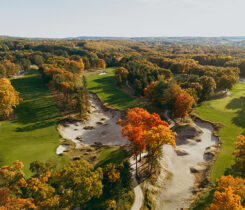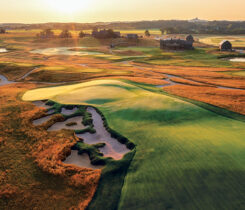Dollar spot susceptibility on bentgrass

Dollar spot injury on select creeping bentgrass cultivars in the putting green study in Manhattan, Kan., on Oct. 2, 2009. Plots in the top row were treated with fungicide only on July 7, 2009. (Photo: Cole Thompson)
Ask a fellow superintendent to list the top 10 problems that influence his or her agronomic programing. Contrary to the classic David Letterman style of beginning at the bottom of the list, I would wager that you could predict the majority of the top five.
I can almost hear Paul Shaffer’s audible murmurs rubber-stamping each mention of overall budget, labor and resource availability, event schedule and the expectations of clientele.
Agronomic considerations may not directly show up until the middle to bottom of the list. These items will begin to vary by climate and grassing scheme and may be more difficult to predict. However, if your colleague is growing bentgrass (Agrostis spp.), it’s likely that preventing injury from dollar spot (caused by species within the genus Clarireedia) would land squarely within his or her top 10. It’s simply one of the more persistent maladies of the bentgrasses.
Dollar spot management
Though cultural strategies may limit injury from dollar spot, fungicides often are required for successful management. However, the repeated use of site-specific chemistries has led to the selection of populations of the dollar spot pathogen that are resistant to some active ingredients. You can reduce dependence on fungicides by establishing bentgrass cultivars that are less susceptible to dollar spot infection. Researchers have shown that less-susceptible cultivars delay disease development, ultimately limiting the annual number of fungicide applications required for acceptable control.
So, what’s the best way to select a cultivar? Each of the previously mentioned studies evaluated a few cultivars at one location in separate experiments. Data from the National Turfgrass Evaluation Program (NTEP) are more widespread and useful for assessing many traits of interest but still are not ubiquitous.
Traditionally, scientists and superintendents work around this challenge by assuming that the relative resistance to dollar spot observed at one location is consistent over other locations. In 2008, my colleagues and I set out to determine this for 25 bentgrass cultivars in five states in the Central United States.
Replicated plots
We seeded replicated plots of 24 creeping bentgrass (A. stolonifera) cultivars and Alister colonial bentgrass (A. capillaris) at 44 lbs. per acre in Iowa, Illinois, Kansas, Oklahoma and Wisconsin in fall 2008 or spring 2009 and irrigated and fertilized appropriately through 2010 (Table 1).
We conducted experiments at putting green cutting heights (0.125 or 0.1875 inch) and fairway heights (0.5 inch). Within experiments, each cultivar was split into two plots — one never received fungicide, but the other received a tank mix of boscalid (Emerald 70 WG, BASF Corp.) at 0.36 lb. a.i./acre plus chlorothalonil (Daconil Ultrex 82.5 WG, Syngenta) at 7.14 lbs. a.i./acre in 87 gallons of water per acre. We initially applied the fungicide mix to all fungicide-treated plots at first appearance of dollar spot symptoms in Crenshaw, a highly susceptible cultivar. Subsequent applications followed for all fungicide-treated plots whenever dollar spot symptom coverage exceeded the 5 percent in Declaration (a partially resistant cultivar) putting green plots or 10 percent in Declaration fairway plots. Only putting green studies in Iowa and Oklahoma and the fairway study in Iowa received more than one fungicide application per year based on these thresholds.
Consistency of relative susceptibility
The severity of dollar spot injury varied for bentgrass cultivars within experiments and was generally less with fungicide applications and in the putting green study. Overall, however, a cultivar’s relative susceptibility to dollar spot injury was similar in putting green and fairway experiments with or without fungicide applications. Kingpin and Memorial had the least dollar spot injury under all scenarios (putting green and fairway, with and without fungicide), and Crystal BlueLinks, Declaration, L-93 and SR1150 were consistently similar (Figures 1 and 2).

Dollar spot injury (measured as an area under the disease progress curve) for bentgrass cultivars at putting green height and without fungicide treatment. These data are a mean of responses in Kansas and Wisconsin in 2009, as well as Kansas, Iowa, Oklahoma and Illinois in 2010. Means under the same horizontal bar are not statistically different according to Tukey’s honest significant difference test (P ≤ 0.05). Click on photo to enlarge. (Graph: Cole Thompson)
Crenshaw and Century had the most dollar spot injury in all scenarios and were never in the same statistical group as any of the previous cultivars. Further, dollar spot injury data were positively correlated (> 0.94) with all evaluated management scenarios across all locations, which indicates that genetic differences in dollar spot susceptibility were consistent in each experimental location and management scenario. Thus, golf course superintendents should feel comfortable using NTEP or similar data to assess relative dollar spot susceptibility of bentgrass cultivars, even when close-proximity data are not immediately available.
Acknowledgements
We extend thanks to colleagues who cooperated on this research and to Barenbrug USA, Lebanon, Links Seed, Proseeds, Scotts, Seed Research of Oregon, J.R. Simplot, Tee-2-Green, Spring Valley and BASF for seed, fertilizer and fungicides used for this project.
References
Abernathy, S.D., R.H. White, P.F. Colbaugh, M.C. Engelke, G.R. Taylor, and T.C. Hale. 2001. Dollar spot resistance among blends of creeping bentgrass cultivars. Crop Sci. 41:806-809.
Koch, P.L. and J.P. Kerns. 2012. Relative resistance of creeping bentgrass cultivars to Sclerotinia homoeocarpa and Typhula incarnata. Online. Appl. Turfgrass Sci. doi:10.1094/ATS-2012-1022-01-RS.
Ryan, C.P., P.H. Dernoeden, and A.P. Grybauskas, 2012. Seasonal development of dollar spot epidemics in six creeping bentgrass cultivars in Maryland. Hort. Sci. March. 47(3): p. 422-426.
Settle, D., J. Fry, and N. Tisserat. 2001. Dollar spot and brown patch management strategies in four creeping bentgrass cultivars. Crop Sci. 41:1190-1197.
Thompson, C., Q. Zhang, M. Kennelly, J. Stier, C. Blume, N. Christians, J. Fry, D. Martin, J. Ostrander, K. Rincker, D. Settle, and D. Soldat. 2019. The dollar spot susceptibility of 25 bentgrasses is consistent across five states in the central U.S.A. Crop Forage Turfgrass Manage. 5:180075. doi:10.2134/cftm2018.09.0075.













